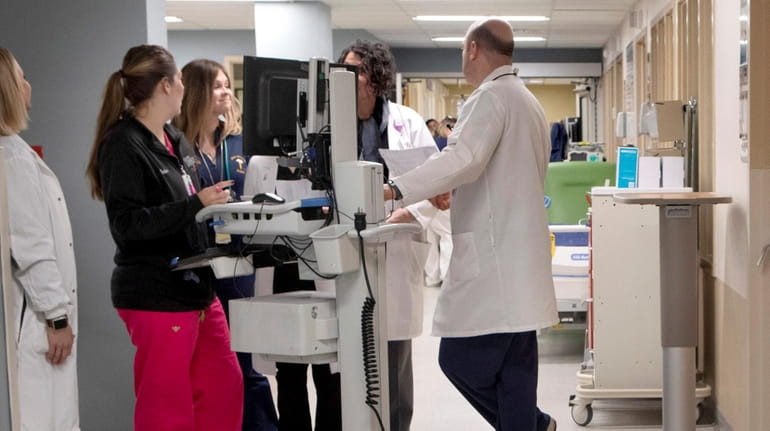Worker shortage looms as Long Island birth rate drops, study says

The health care industry employs the most workers in the 20 to 39 age range. Here, staff at Good Samaritan Hospital Medical Center in West Islip are shown on Jan. 18. Credit: Jessica Rotkiewicz
A shortage of workers looms on Long Island as the number of people age 0 to 19 fell 7.5 percent in the past seven years, according to a new report.
The shrinking number of children and teenagers in Nassau and Suffolk counties will soon translate into fewer workers age 20 to 39 — which will have big consequences for employers and for the entire regional economy, the Long Island Association Research Institute said in an eight-page study to be released Tuesday.
The decline means that encouraging more reverse commuters to travel from New York City to Island jobs will be critical to filling future hiring needs, the study’s authors concluded.
The institute, a division of Long Island’s largest business group, found the number of 0 to 19-year-olds dropped from 742,132 in 2010 to 686,184 in 2017, the most recent available data from the U.S. Census.
“Over the next 10 to 20 years, regional industries and institutions that either serve or depend on people between the ages of 20 and 39 will likely feel the effects of the 0-19 population decline,” the study states. “People at these ages tend to buy homes and rent apartments, and are therefore likely to spend money in consumer and service markets necessary to encourage and sustain households.”
LIA CEO Kevin Law said the Island’s drop in births is caused by people deciding to have fewer children or no children, high housing costs and growing numbers of women attending college and pursuing careers — the same factors behind the decline in the number of births nationwide.
“Long Island is like the rest of America, only more so,” he said on Monday, adding some young people are opting to leave the region.
Law and others said reverse commuters could help solve the forthcoming worker shortage.
Their number will increase with the Long Island Rail Road’s third-track project from Floral Park to Hicksville and direct access to Grand Central Terminal, the study states. The number of reverse commuters totaled 116,292 in 2017, up 27 percent from 2010.
Law also said Island residents should embrace more apartments in downtowns, workforce training and more child-care options to keep young people from leaving for other states and regions.
The Island had a net loss of 5,313 people age 20 to 39 in 2017, and only gained 2,931 in the same age group from foreign countries, census data show.
Another potential remedy is encouraging young people to enter the workforce who have stayed out because of disability, drug addiction or “the proliferation of low wage or dead-end jobs,” Law said.
More than 138,500 people age 20-39 were not in the labor market in 2017. Thirty-nine percent of those were attending college. The age group accounts for 20 percent of the Island’s potential labor force, according to the census.
Among the industries that are heavily reliant on young workers, health care employs the most: 59,000 workers age 20-39 in 2017, the study said.
Northwell Health, the state’s largest private-sector employer, is paying “close attention” to the shrinking number of young people, said Joseph Moscola, chief people officer for the health care system that’s headquartered in New Hyde Park.
He said, “Today 40 percent of our workforce are millennials and we expect that number to cross the 50 percent mark by 2020.”
Moscola also said Northwell is attempting to develop a pipeline of future employees by introducing 11th and 12th graders to health care occupations through an annual competition and scholarships for students majoring in science, technology, engineering or math.
Fewer births is a more immediate challenge for businesses reliant on a teenage and college-age workers, such as tourism.
Kristen Jarnagin, CEO of the tourism promotion agency Discover Long Island, said, “A decreasing population of young workers in our region, coupled with many of our young residents choosing to leave Long Island due to affordability and a negative perception of our quality of life, limits our ability to welcome visitors and provides challenges to the thousands of small businesses who rely on our visitor economy.”
Colleges and universities “are likely to be the institutions most directly affected by the decline in youth population,” the institute said.
At Molloy College, administrators have been responding to demographic changes for about a decade.
Michael Torres, vice president of institutional effectiveness, said Monday the Rockville Centre college is poised to open its third dormitory, which allows for recruiting students from farther away. Affordability and a good job upon graduation are key recruitment messages, he said.
“We’re expecting to see a 14 percent decline in high school graduates in Nassau County and a 13 percent decline in Suffolk County between 2008 to 2020,” Torres said. “We’ve been prepped for this for the last eight or nine years.”
Thanks to recruiting, the size of Molloy’s freshman class has increased 22 percent since 2014 and the number of graduate students is up 33 percent, he added.
Adelphi University is responding to the Island’s demographics by touting its “highly personalized approach towards education,” said Kristen Capezza, enrollment management vice president. The Garden City university “is preparing students with hands-on learning and exciting research opportunities” with professors.
Feral cat found with rabies . . . Piano Man's last show . . . Travel to Block Island . . . Olympics opening ceremony
Feral cat found with rabies . . . Piano Man's last show . . . Travel to Block Island . . . Olympics opening ceremony

